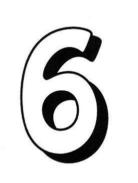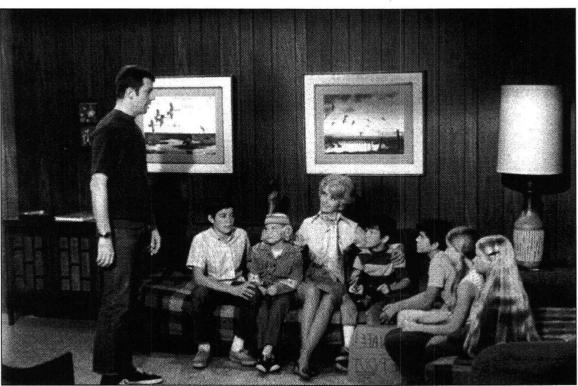Growing Up Brady: I Was a Teenage Greg, Special Collector's Edition (11 page)
Read Growing Up Brady: I Was a Teenage Greg, Special Collector's Edition Online
Authors: Barry Williams;Chris Kreski


 e started shooting the pilot episode of "The Brady
e started shooting the pilot episode of "The Brady
Bunch" on my fourteenth birthday, and six months
later, much to my delight (and Robert Reed's horror),
ABC bought it! Then we got really busy. The show
was set to premiere in September of 1969, and by midsummer we
were filming at an absolutely furious pace. It was hot, grueling
work, and all I can say is that I was in heaven.
One of our first
cast photos.
(© Paramount
Pictures)

Brady Bunch
Sound Stage 5
(Barry Williams)

For me, there was always an air of excitement about going to
the studio. Despite the long hours and hard work, I looked forward to each day on the Paramount Stage 5 with a real sense of
anticipation. To me, it was even more exciting than Disneyland.
Who needs Frontierland or Adventureland when you have the
"Star Trek," "Mission Impossible," "Bonanza," "Odd Couple,"
"Love, American Style," and "Happy Days" sets to play on?
I loved it so much that I'd usually have my mom get us there
early. I'd hang out, bother the assistant directors, say hi to Mrs.
Whitfield, our welfare worker/teacher, ask the tech guys about
nine hundred questions, and then sneak out for my all-important
first cigarette. After I'd sufficiently blackened my lungs and stimulated my brain, I'd head back to the set, check in with wardrobe
and makeup, and be in place, ready to go, all before my official
eight A.M. call time. Such was my morning routine, day after day,
season after season.
Scripts were handed out, and each Brady would take time to go
over the script, and offer (generally) constructive input. Mostly
we'd ask for minor line changes-things like avoiding a scriptwriter's "neat-o" where a "groovy" or "far out" belonged. Pretty funny
in retrospect, but I can remember taking that duty very seriously. To our producers' credit, our suggestions almost always met with a
positive response.
Then it was time to bring the script to life as we began to
rehearse and shoot. That sounds like two separate processes, but
in our case the two were always mixed together. Ours was a onecamera, filmed sitcom, as opposed to the three-camera, live-ontape shows that are popular today. It's a more difficult and timeconsuming shooting process because we couldn't simply run
through the show in front of a studio audience. Instead, it had to
be pieced together, one scene at a time.
It's a tedious method, but Lloyd Schwartz tells me that we
endured it for a very definite reason. "Three-camera shows suffer
in terms of kids, because it's very hard for them to sustain their
concentration level for a full thirty minutes. From day one we
knew that there were gonna be kids all over our set, and that the
best way to shoot `The Brady Bunch' would be to take our time
with it, shoot it with just one camera, mostly in close-ups that we'd
knock off a couple of lines at a time.
"Nowadays they throw these kids in front of a live studio
audience and expect them to perform. Watch any kid on a threecamera sitcom and you'll find that it almost never works. In a bestcase scenario they seem plastic and artificial, and at their worst they
can be just plain unwatchable. So what we did was proper, I think,
and really made the Brady kids much more believable as kids".
Studio time is ridiculously expensive. Even in 1972, it cost over
$100,000 to produce each "Brady Bunch" episode. With that in
mind, our producers left nothing to chance. Each evening, a call
sheet was posted listing in detail the scenes that we'd film the fol lowing day, the order in which they'd be shot, which characters
would appear in each, and what time we were expected to report.
For the cast and crew of "The Brady Bunch", this was a very important piece of paper. We followed its instructions religiously, and to
the letter.

Mike lectures
the Bunch.
(Courtesy Sherwood Schwartz)
Throughout the day, we Brady kids spent most of our time
either in the studio schoolroom or on the set. Whenever one of
our scenes was being readied, an assistant director would find us
and herd us over to the set for rehearsal. This began the creative
part of the "Brady Bunch" process.
For each scene, the participating actors would get together with
the episode's director and give it a workout. We'd experiment, try
things out, play with blocking, line readings, camera angles, and
also work through the logistics of the scene. This was the niche in
the creative process wherein we'd answer questions like "Where
should I enter from?" and "How perky should I be?" and "How do
we smack Marcia in the nose with a football and not bust it in the
process?" It was fun, and we'd work on the scene until it had
shaped up to the point where everyone was satisfied that it was
ready to shoot.
At this point, we actors would dash off the set, and into
wardrobe (we didn't generally don our bell-bottoms until the very
last minute). Simultaneously, the crew would be lugging lights,
loading cameras, and making sure every last prop detail had been
readied.
Once the lights and camera were set, all that was missing was the
action, and that's where we came in. We'd assemble on the set, lines
firmly implanted in our cerebellums, and we'd shoot each scene.
First, we'd knock off a wide-angle master shot, with all of the
actors in the scene pretty much visible throughout. It serves as a
sort of overview for the scene and is used as the starting point later
on in the editing process. Once we'd knocked off a decent take,
the director would move in for closer coverage. On most shows
this would entail shooting a couple of close-ups, but when you're
producing a sitcom overflowing with main characters, you'd sometimes have to combine actors and shoot tight two-shots, threeshots, or even our most unique creation, the very intimate "tight
nine." You've really gotta love your fellow actors to squish up to
them that tightly.
Look closely at almost any "Brady" episode and you'll notice
that whenever you happen across one of those tight nines, I'm
generally pressed quite tightly up against Maureen McCormick. I
was no dope.
Anyway, between each camera angle, the lights have to be
changed, the camera has to be moved, cables have to be pulled, and chaos reigns supreme. Consequently, we kids would be
expected to stay out of the way and inside the schoolroom. Fun,
huh? Once, however, you had built up the daily school-time minimum of three hours, it was okay to hang out on the "Brady" set, or
sneak into the sets of other shows (I used to love watching Jack
Klugman and Tony Randall tape "The Odd Couple"). Sometimes,
we'd just find a way to cause trouble. That's because Lloyd
Schwartz went out of his way to guarantee that at any given time,
any one of us Brady kids could break an arm.
That sounds like a joke, but it's not. I1oyd explains it: "One time
the kids were running around like lunatics, as kids do, and I was
ordered to put a stop to it. I was ordered to keep 'em off the overhead catwalks and off the backyard swings on the set, and basically
to put 'em in glass cases and pull 'em out for their close-ups. So I
went to the president of the studio and said, `I'm not gonna do
that, because what's coming across on-screen is that these are real
kids, and the minute we start imposing these restrictions on them,
we'll remove them from being real kids, and on-screen, they won't
react as real kids. I hope it never happens, but every one of those
kids needs a chance to break an arm.' And they said okay."
So thanks to Lloyd Schwartz, we Brady kids spent a blissful five
years running amok throughout the Paramount lot, having fun,
driving people crazy, and generally, just being kids.

